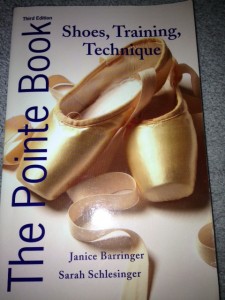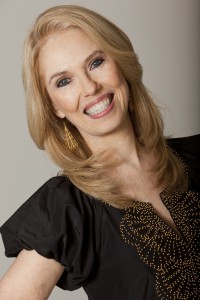Janice Barringer knows more than most people about a subject that is near and dear to the heart of ballet dancers — pointe shoes. She is the author of the most comprehensive book I have ever seen on the subject, The Pointe Book, and since one of our themes this quarter is footwear and foot care, it seemed only natural that she should be the person to talk about pointe shoes…
I’m sure readers will find some interesting tidbits in the interview below!
 Where did the idea come from to write this book?
Where did the idea come from to write this book?
A dear friend of mine, Sarah Schlesinger, was a writer, a lyricist and the owner of a Capezio Dance Store. Her mother was a ballet teacher and her godparents were part owners of Capezio. She knew I had contacts in the ballet world, and also felt strongly that a book about pointe shoes needed to be written. Several customers were furious that the shoes they had bought from her store were wearing out. The father of one ballet student actually struck an employee in anger because he thought they had been cheated—–given defective shoes. Sarah said, “if only there was a book that I could pull out to prove that pointe shoes are built to wear out. This was before some of the new types of long-lasting shoes were on the market.
She repeatedly asked if I would take on this project. At the time I was dancing professionally and teaching a guest class now and then. The idea of writing a book did not interest me even though Sarah said she would write the proposal, and guide me if I provided the information. (The Second and Third Editions I wrote by myself). One day I was in my chiropractor’s waiting room. Dr. Nathan Novick was a kindly, older man that took care of many professional dancers as well as his normal clientele. There sat Martine Van Hamel right across from me. I have no idea why, but suddenly I decided, “today I’m starting the book about pointe shoes.” I grabbed some scratch paper and asked Martine if she would tell me what shoes she wore, what size, how did she prepare the ribbons, elastics, what did she do to break them in, what kind of padding did she use etc. She answered graciously, and the book began. I couldn’t wait to call Sarah to tell her that the inspiration had struck!
From there it was easy. David Howard was my teacher and his classes were and still are filled with some of the greatest dancers in the world. I saw them everyday. In the dressing room at the end of class I would ask dancers all about their shoes. Alessandra Ferri had just finished the movie, “Dancers”, and she told me in detail all about her shoe issues, and also about something that was new to me at the time—-vamp elastic. After talking to many wonderful dancers, I decided I needed to go to the leading schools to find out how they set up their pointe programs. Since I was in New York, I started with The School of American Ballet.
It snow-balled from there. I kept getting ideas of knowledgeable people to interview and no one ever turned me down. The two years that followed were the most exciting years of my life. I went all over the country and to Europe twice. As I interviewed leading dancers, teachers, directors of schools, owners of pointe shoe companies, and medical professionals, I also attended performances, rehearsals, classes, meetings of the greatest people in the ballet world.
What are the main topics that this book covers?
It begins with a short history of pointe work. There are some humorous moments in this chapter. It then moves to the structure of the foot and the pointe shoemaking process, fitting, preparing and caring for the shoes. Top teachers like David Howard, Suki Schorer, Peff Modelski and others have contributed to The Basics of Teaching Pointe chapter. There’s a chapter with interviews of the men in charge of pointe shoes for both American Ballet Theatre and The Birmingham Royal Ballet where they tell us all kinds of amazing facts about securing, dying, and caring for shoes for their dancers. I have put in a chapter that is 44 pages long that is called Pointe Shoe Characteristics. This is a cross-reference which helps a dancer find the shoe that will best meet her requirements. It has categories in it such as very narrow shoes, very wide shoes, shoes for high insteps, shoes for a longer second toe, very light shoes, unusual shoes, long-lasting shoes and on and on. There is a chapter about the pointe programs in many major ballet schools. Included in this is The Paris Opera Ballet School, the Royal Ballet School, The School of American Ballet, Canada’s National Ballet School, The Goh Ballet Academy in Canada, The Kirov Ballet Academy in Washington D.C., and many others. I have notated classes I observed at the Jacqueline Kennedy Onassis School at American Ballet Theatre, The San Diego Ballet School, Ballet School, NY, and others. In this chapter there is a very informative interview of Franco De Vita, Principal of the JKO School. Other chapters include pointe shoe accessories, a pointe shoe sizing chart, pointe related injuries and their remedies and conversations with leading ballet dancers about their shoes, their feet and how they solved their pointe shoe issues.
What was the most surprising thing you learned while writing the book?
What really surprised me was how willing all these great people were to share their knowledge and secrets. It was a thrill to sit for hours as the leading people in this field told me almost everything they knew. They didn’t ask for money and they didn’t even place any restrictions on me. Many of these people asked me to get in touch with them after I had spoken to others because they were interested in what everyone had to say. What a thrill!

For teachers–what are some key things to keep in mind that might not be obvious?
What I am going to say was covered in the book. Sadly, there are some body and foot types that just cannot be taught to dance on pointe. No matter how good the teacher, some bone structures just don’t work and never will no matter how hard a student tries. Also, if a dancer is having a difficult time, it may be because she isn’t wearing the proper shoe. Finding the perfect fit is paramount to dancing en pointe. That doesn’t just mean the right length and width, but also—-how long is the vamp, what type of shank (such as redboard or a new elastomeric type) and how thick and long is it, how high or low is the profile or crown and on and on.
Can you share some interesting tips for preparing pointe shoes?
This is covered extensively in the book. Professional dancers are very picky about how they prepare their shoes because their whole reputation and the quality of their performance depends on the shoes not letting them down. Here are some interesting facts: some people sew their ribbons with dental floss because it’s stronger than thread; after manually breaking the shoes in, many people them put jet glue inside the box, on the tip or on the shank to reenforce areas that need more strength; others cut out part of the shank to make the shoe more flexible; a few dancers actually break the shank for more flexibility ( I don’t recommend this for students); a box-cutter is used to shave the edge of the bottom of the soles for a more secure balance while off pointe; small hammers are used to bang on the bottom of the box so that landing from a jump doesn’t make a lot of noise.
What can dancers do to prevent injury when it comes to pointe work?
They should read the book first because there are lots of suggestions as to how to approach pointe work intelligently. For instance, getting a good fit is imperative. A shoe that is too big could cause the dancer to fall off pointe, possibly sprain an ankle. Also, the ribbons and elastic need to be tied and affixed so that the foot is secure in the shoe, but not too tight. Most important is finding a good teacher and then follow his/her instructions exactly. This is not a time to “do it on your own”. Weak feet, ankles, legs and body in general will inevitably lead to injuries. The careful repetition of specific exercises will develop the strength needed to dance well AND prevent the possibility of injuries.
Who can benefit from reading or owning this book?
Our original idea was to make it beneficial for students, their parents, teachers and professional dancers. That was a big order, but it has worked out that way. The First Edition of the book came out in 1990, and over the years I have had people from all those categories tell me how much it has benefited them.
BIO: Janice Barringer was raised in Florida and received her early training in ballet, jazz, tap and acrobatics from Edith and Bill Royal. Upon deciding to focus on ballet, she moved to New York City and traveled to Europe where she studied with leading teachers in the field. Janice danced professionally for many years before becoming a ballet teacher and writer. She has written for Pointe, Dance, Dance Teacher, and Dance Spirit Magazines, and is the author of 9 cover stories for Dancer Magazine. Her first book, The Pointe Book, has given her a reputation around the world as being a leading authority in this field. An updated third edition was published in May, 2012. She also is the co-author with Thalia Mara of another book on pointe work called On Pointe. In addition to detailed information about working en pointe, it has a history of the first International Ballet Competition in the United States which is held in Jackson, Mississippi, every four years. Janice has written a ballet syllabus, produced by Music Works Unlimited, complete with corresponding CD’s and DVD’s for each grade. It is specifically created for the dancing school teacher. The last four years she was employed at Pace University in New York City as a ballet instructor. She now spends most of the year in her native Florida teaching at South Beach Dance Academy in Daytona Beach returning frequently to New York, as well as teaching as a guest instructor in studios, at workshops and conventions around the world.





This is a great interview! I really admire Janice for documenting this valuable information about the wide world of pointe shoes. As a pointe shoe fitter myself, there is SO much more to pointe shoes than meets the eye. Some fittings can last hours, just to find the perfect shoe! I’d love to read this book!
Thanks Amanda! The book is really amazing, I have to say–I think you’d love it! Stay tuned for more from Janice–she’ll be writing posts for the site in the coming months and joining our contributing writer roster!
This book sounds great! Off-topic: I would love to learn to fit pointe shoes -not for a job but just to enhance my work as a ballet instructor. I can’t seem to find any guidance for this, tho. Any suggestions?